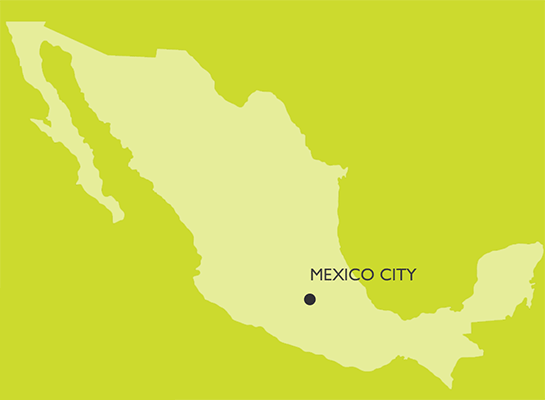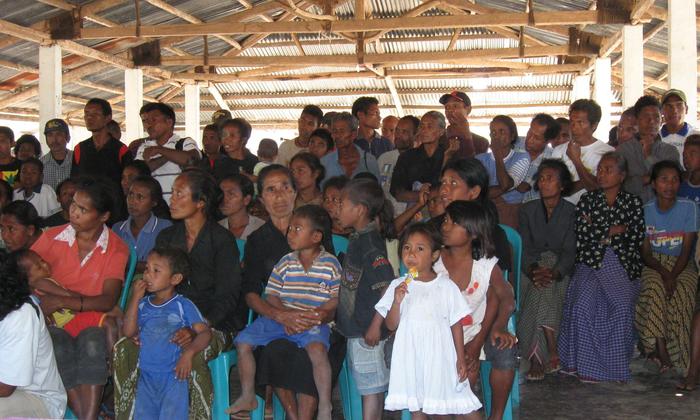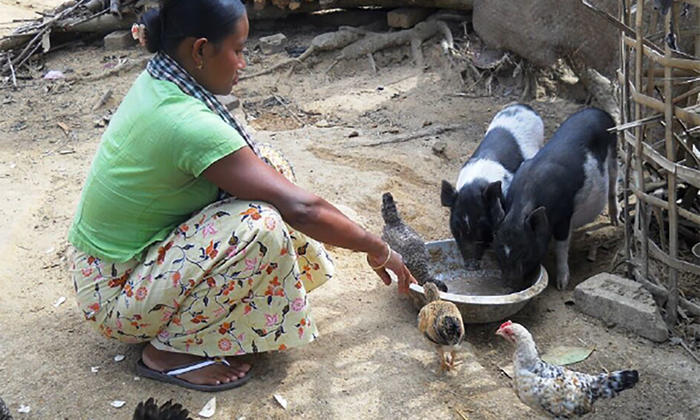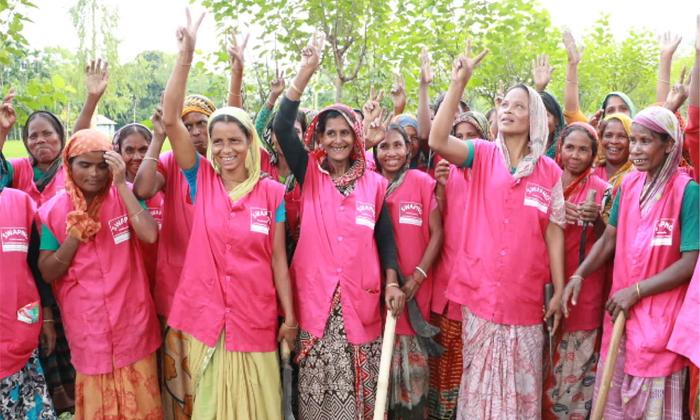The displaced population faces unique conditions of marginalization and greater disadvantages because, in addition to poverty, they are less able to access basic health and education services
Case study
Peace building for the displaced in Chiapas, Mexico

SDGs ADDRESSED
This case study is based on lessons from the joint programme, Conflict prevention, development of agreements and peace building for internally displaced persons in Chiapas, Mexico
Read more
Chapters
Project Partners




1. SUMMARY
The displaced people of Chiapas are the great forgotten victims of the armed conflict between the Zapatistas and the Mexican state which began in the mid-1990s. The intervention aimed to work with state and local authorities for the reduction of conflicts in Chiapas. It benefitted 25 communities with displaced persons in five municipalities in the north of Chiapas, including Tila, Tumbalá, Sabanilla and Salto de Agua, all of which have a majority speaking the indigenous language Ch´ol. The programme also included an intervention focused on the city of Ocosingo, the second largest city in the municipality. The strategy revolved around three axes:
- The promotion of public policies to strengthen the rule of law and human rights by improving access to housing for the displaced population.
- Institutional development of criminal justice, the prison system and social security.
- Reducing conflict by building a culture of peace and by rebuilding social fabric.
Among other results, there was promotion of the Law on Internal Displacement in the state of Chiapas, which improved access to justice for the displaced population. There was also the promotion of a strategic plan focused on the enforcement and pursuit of justice, and technical training given to both state and police agencies. A culture of peace was promoted in more than 25 localities of the intervention in the Ocosingo, Sabanilla, Tila, Salto de Agua and Tumbalá municipalities through a programme based on art, sports, activities at schools and the creation of a diploma in the culture of peace and multiculturalism. Moreover, 1546 infrastructure projects improved access to housing for the displaced population, through the joint work of two civil society organizations: the Centre for Training and Advice in Environment and in Health Rights (Camadds A.C. Centro de Capacitación y Asesorías Medio Ambiente y Defensa del Derecho a la Salud), in the Salto de Agua municipality, and Foro A.C. in the Tila municipality, which provided technical support throughout the process.
The intervention was undertaken in a post-conflict context where there are highly complex and dynamic contexts, which affect social, cultural, political, economic and environmental variables. This case study aims to present the lessons learned, the results, and practical examples that came out of this experience, in a way that will serve to improve knowledge relating to conflict prevention and peace building programmes.

The State of Chiapas has faced the phenomenon of internal displacement forced by various causes throughout its history
2. THE SITUATION
Chiapas is a state which has had to deal with forced internal displacement for a variety of reasons throughout its history. Between 1950 and 1970, the main reasons were the construction of major development projects, such as hydroelectric dams and oil wells. Between 1970 and 1990, the main cause was religious intolerance and, to a greater extent, socio-environmental phenomena-related disasters. Finally, internal displacement in Chiapas gained high visibility due to the armed uprising of the Zapatista Army of National Liberation (EZLN), when thousands of people had to abandon their communities due to bombardments, widespread violence caused by clashes between the EZLN and the national army, and inter-community conflicts due to political differences the latter being a condition which has so far prevailed in many indigenous communities in the state.
The displaced population faces unique conditions of marginalization and greater disadvantages because, in addition to poverty, they are less able to access basic health and education services. They often suffer from the breakdown of social fabric, and the lack of social protection services, as well as have high vulnerability in terms of access to justice. There is no legal framework that addresses them or ensures the creation of public policies that respond to their specific needs. Also, as the cycle of displacement has not ended - this would involve the creation of a secure and economically sustainable method which integrates displaced families into a local area - the displaced population’s unsolved problems allow their exclusion to continue to get worse, directly affecting their long-term development.
3. STRATEGY
The programme was aligned with the National Development Plan and with the Chiapas State Solidarity Plan in the implementation of a comprehensive intervention strategy based on three axes:
- Promotion of public policies to strengthen the rule of law and human rights through access to housing for the displaced population.
- Institutional development of criminal justice, the prison system and social security.
- Reduction in conflict by building a culture of peace by rebuilding the social fabric.

The displaced population faces particular conditions of marginalization and of greater disadvantage

4. RESULTS AND IMPACT
The intervention began with a comprehensive assessment of the internally displaced population in the north in terms of the level of enforcement, delivery and administration of justice and the police and prison system. This assessment was developed, published and disseminated with recommendations to state bodies, with the goal of improving the justice system.
Once updated and correct information was available on the situation of the displaced, the programme managed to significantly impact the formulation of public policies aimed at the population of internally displaced persons at state and local levels. Specifically, the Congress of Chiapas unanimously approved the Law for the Prevention and Assistance of the Internally Displaced. This approval was the result of a process of collective and inclusive participation, coordinated by UNODC, which managed to obtain the collaboration and involvement of certain public powers (executive and legislative powers of the state government), as well as the participation of civil society organizations, state and national academies, UN agencies linked to the programme, and the UN Refugee Agency (UNHCR) as a special guest.
The adoption of this law was the result of a process of dialogue, discussion and collective awareness in order to better promote access to justice for the most vulnerable groups. The law emerged as a comprehensive and far-reaching response to one of the main demands of the displaced. It recognizes the legal status of a displaced person, sets identification criteria/conditions to prevent foreseeable displacements, and establishes mechanisms for assistance and for durable solutions to displacement. There was also the creation of a formal registry of the displaced population in the state within the Secretariat of the Government’s operational framework, and the creation of a State Board to monitor its implementation. In the municipalities where the programme is supported, the law rests within a broader framework. This law is the first legal tool on the issue in Mexico and is being used as a reference model elsewhere in the country.
In terms of strengthening institutional capacities, the programme made significant progress in achieving changes in attitude and in the acquisition of technical skills from public ministries, social advocates, experts, and state and municipal police who have jurisdiction and cover a total population of 1,806,635 inhabitants. The changes are a result of successive courses on assistance for the displaced population, conflict prevention, and building a culture of peace. These officials received certification so that they could be formally recognized by the Federal Government as the users and trainers of the new penal justice system at state level. The process of bringing judicial and public institutions closer was ended by distributing 1000 copies of an orientation guide for access to justice, which reports on, and encourages, the use of statutory legal justice.
The programme made significant progress in achieving changes in attitude and in the acquisition of technical skills from public ministries, social advocates, experts, and state and municipal police who have jurisdiction and cover a total population of 1,806,635 inhabitants
A variety of activities were organized to rebuild the social fabric among young people and to build a culture of peace. The agencies worked together to create space for dialogue and expression in which they proposed methods to peacefully resolve conflicts. In these spaces, “communicators” were trained by civil society organizations specialized in community communications, such as the Red de Comunicadores Boca de Polen (Boca Communicators Network) and Enlace Comunicación y Capacitación A.C (Enlace Communication and Training).

A forum for democratic dialogue was developed with the participation of displaced groups leaders
More than 65 youths, men and women that participated in this process decided on the means of communication in which they could develop their ability to promote peaceful messages.. This training process triggered other important, parallel processes, such as the establishment of Educational and Cultural Community Centres- places where communicators could continue their work and their commitment to their communities by communicating local problems and solutions to them, particularly about peaceful resolutions to conflicts and building a culture of peace.
Also, a Forum for democratic dialogue was developed during the implementation of the programme, which was established as a space for interactive and dynamic dialogue, with meetings between participants with different interests and perspectives who came together to formulate proposals and identify the needs surrounding forced internal displacement. It relied on the participation of more than 80 men and women who were state, federal and municipal officials, as well as members of civil society, academia, officials from the Congress of Chiapas and leaders of displaced groups. The forum helped to get the issue of internal displacement onto the public agenda in the state, and its results provided important input for the groups that worked on a model law on internal displacement. These meetings in turn lead to the exchange of experiences between different displaced groups from different areas, sparking the establishment of a Red de Desplazados Regional (Regional Displaced Persons Network), formed by the grassroots organization Kichán Kichañob, the group of displaced persons in La Cascada de Ocosingo and Tzijib Troñel Zona Norte.
In seeking long-term solutions to the situation of internal displacement, “Discussion Boards” were established in Ocosingo, Kichán and Usipá, through which coordinated state government agencies followed the various problems of more than 5000 displaced families. These spaces managed to gain legitimacy and trust in communities, promoting frank and respectful dialogue.
Also, sports tournaments were held, which brought together young people from different communities, thereby contributing to peaceful inter-communal coexistence. The main result of music and dance activities was an appreciation of traditional Ch’ol music. Musical instruments were given out and meeting other musicians was encouraged, leading to audio and video recordings of seven traditional groups, thereby increasing the musical heritage in the state music library. A television programme about traditional Ch’ol music was also broadcast on Channel 10 in Chiapas.
Regular courses on the prevention of drug use, crime, the prevention of sexually transmitted diseases and gender violence were run. More than 6,000 people benefitted from these courses. Alongside this, workshops were organized which involved 360 adolescents: two focused on the prevention of addiction, and four on the prevention of gender-based violence. 35 teachers (Ch’ol and Tzeltalt) from the Ocosingo, Tila and Salto de Agua regions participated in delivering the Diploma in Culture of Peace and Multiculturalism initiative included the participation of.
Another educational initiative was the design of the Peace Education Toolkit, developed in collaboration with the Asociación Cuenta con Nosotros, Cuentos y Más A.C (Count on us, Stories and More Association). This toolkit is consistent with the point of reference methodologies relating to the free, prior and informed consent of indigenous peoples. Under the programme, there was also collaboration for training on children’s rights delivered to academic coordinators in 33 state teacher training centres, which later also included nine centre coordinators, technical and pedagogical advisers, and the State Human Rights Council. A training process was developed through a series of academic materials on children’s rights at school. About 2000 copies were distributed across the state through the 33 teacher training centres, and the materials were used for approximately 827 groups (24,827 participants). There was also collaboration with the State Department of Continuing Education to deliver a series of seven workshops on human rights and children’s rights as a part of the National Prevention of Gender Violence Week in schools (821 participants in total).
The strategy to improve housing was accompanied by a training course for basic renovations, building, and do-it-yourself techniques, in order to improve local abilities. For do-it-yourself construction projects, construction committees were formed in 17 localities. They were responsible for overseeing construction at 1546 housing improvement projects. Also, they provided technical advice, training, and support for productive investments such as home gardens, producing organic fertilizers, cattle rearing, poultry farming, bee keeping, and the improvement of forest resources in the region. Through this, more than 700 producers were directly supported. With regards to community infrastructure, water systems, multi-purpose spaces, and educational and cultural community centres were constructed.
Regular courses on the prevention of drug use, crime, the prevention of sexually transmitted diseases and gender violence were run
5. CHALLENGES
- Although the participation of different United Nations agencies proved to be a very efficient multi-dimensional method in terms of getting results, a joint administrative plan needs to be created which defines shared channels and procedures with a view to reducing costs and proceeding in a more efficient manner. From the start, the programmes should ensure that they share a clearly-defined communication strategy which will allow them to transmit an understanding of the same to all participants, beyond specific promotional events.
- The UN agencies’ independent methods of administrative management hinder the flow of activities, the quality, and the availability of financial information.
- The rotation of personnel in medium or long-duration initiatives – those longer than two years – creates information gaps and long periods of adaptation, which can only be corrected with permanent information strategies and the maintenance of an institutional, active memory. Systems to avoid the loss of human resources and expertise created during the programme must be developed, in order to guarantee sustainability, alongside the organizational procedures that have been initiated and good practice.

6. LESSONS LEARNED
- The programme is a point of reference on the capacity and impact of the United Nations when its agencies work together in a coordinated and multidimensional manner. Each brings its particular knowledge and experience. However, for the intervention to succeed it is very important for the roles of different agencies to be clear, and for them to reach agreements on common goals, leading to mutual learning among agencies and the other institutions involved.
- Increased coordination between agencies occurred on an operational level. A major strength of the programme was that the four agencies were set up in the same office in San Cristóbal de las Casas, which not only generated overall savings in rent, but also led to better operational planning, for example in the use of field vehicles and for visits to follow up on actions.
- Programme design is important. In programmes aimed at indigenous populations and in those where conflict is addressed, the viability of strategies cannot be taken for granted. The programmes designed from central offices, without close prior knowledge of the reality on the ground, lead to implementation problems which will probably mean them having to be altered. Performing an assessment prior to the intervention is vital to knowing the strengths, weaknesses, opportunities and threats to the prevention of violence and peace building. Accurate information is critical for developing public policies and making decisions.
- It should be ensured that the design of programmes avoids actions which could take the place of government initiatives. On the other hand, actions should also be geared towards strengthening public institutions and producing cooperation among diverse participants.
- Formalization under institutions has positive effects on strategies. Therefore actions should always aim to promote relationships with other parties, and preferably, the work of the United Nations should be in strengthening institutions. A successful example of institutionalizing a programme was the accreditation of the Diploma in Interculturality and Culture of Peace, promoted by UNESCO in collaboration with the Ibero-American University, through the Dirección General de Formación Continua de Maestros en Servicios de la Secretaría de Educación Pública (Directorate General of Continuing Education for Teachers in Service of the Secretariat of Public Education), which was endorsed as a teaching career. This led to massive demand from the teachers in Chiapas.
- In communities with a high level of internal conflict or in conditions of high marginalization and poverty, one cannot select a set of beneficiaries (for example, the displaced) which excludes the rest of the community. The intervention must benefit all of the community or, alternatively, the beneficiaries must be selected through institutions with community representatives.
- The development of the programme’s strategies substantially improved when they were incorporated into the team of fieldwork supervisors who shared the same language and culture of the population in this case the Ch’ol culture. The constant presence of field supervisors is of utmost importance, not only for monitoring work, but also to build trust with communities.
- In future programmes for conflict prevention and creation of a culture of peace, it is important for interventions to prioritize building social relationships of trust and solidarity within communities, as this is necessary for undertaking interventions focused on promoting collective action at the community level.
- The involvement and awareness of all parties involved was key for getting support from and partnering with municipalities. It is important to respect and properly plan for the different processes and timelines of each of them to avoid becoming overloaded with activities.
7. SUSTAINABILITY AND POTENTIAL FOR REPLICATION
The practices adopted may serve as a point of reference for other conflict prevention and peace building projects being undertaken in Mexico, and also in other countries.
To strengthen the sustainability of the Law for Prevention and Assistance of the Internally Displaced in Chiapas, the programme contained provisions which would counteract any potential withdrawal of the state’s executive authority, and ensure that it was ultimately established as legislation. To this end, five information forums were held in the communities, where they imparted knowledge about the recognized rights of the displaced population, with an emphasis on the importance of their participation within the community to insist on these rights being upheld. It also drove the adoption of the law with those responsible for its drafting, so that they would continue to promote the establishment of the legislative initiative at the national level and in other states in the country. It should be noted that UNODC also designed an exit strategy that consists of two documents. In one, the process, methodology, lessons learned and good practices of drafting the bill are standardized, with the objective of being able to replicate it in other legislative processes. This document was transferred to the State Government and spread among various stakeholders at the national level. The other is a document with recommendations for an initiative for a model law on internal displacement, which was also sent to the State Executive.
The sustainability of actions in the educational sector is highly likely to have a permanent effect (in terms of knowledge and awareness of teachers) over time. The sustainability of the Diploma in Interculturality and Culture of Peace reached an important milestone in that the programme and its contents were accredited by the Directorate General of Continuing Education for Teachers in Service of the Secretariat of Public Education (SEP) as part of the National Catalogue of Professional Qualifications and was endorsed as a “Carrera Magisterial” (an officially recognized teaching specialization).
In terms of improving housing, the intervention established knowledge within communities for building cement floors, stoves, latrines and other housing projects, as well as imparting skills to operate and maintain the community infrastructure. Also, the participation that was achieved with the community assemblies, through which beneficiaries collaborated on the creation of the infrastructure, supervision, and inspecting work, contributed to social cohesion. In terms of the component aimed at improving income, the interventions undertaken in cattle rearing and beekeeping are highly likely to persist over time, considering that the beneficiaries were already performing these activities. However, in the case of vegetable gardens, there should have been more focus on distribution and marketing channels.








